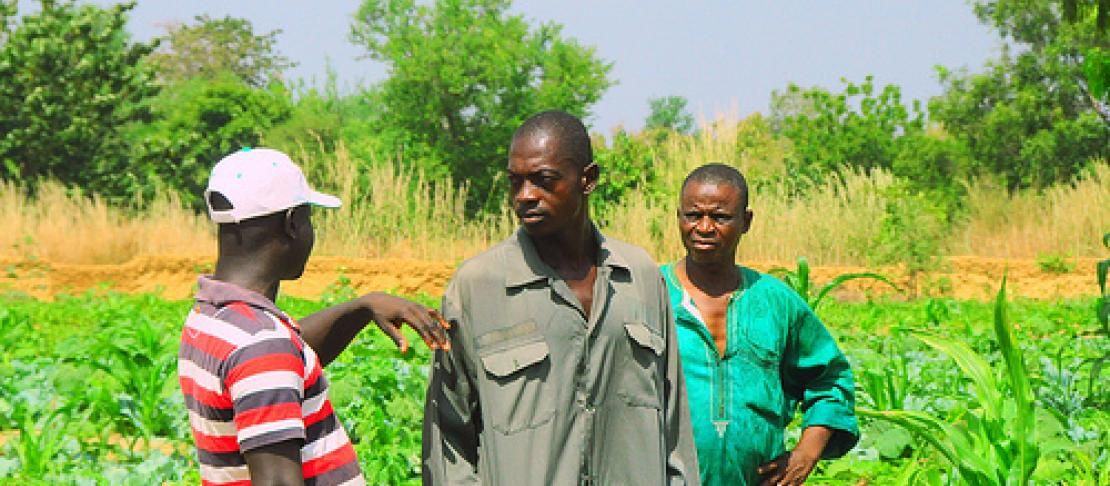Defending a vegetable farm against drought

His name is written “Naakpi” and pronounced “Naakwi”, that we understood fast. But it took us much longer to comprehend why Naakpi looked so tired, and walked around with a back bent as if he had a burden too heavy for one man to carry.
We understood even less as we walked through an opening in the earth wall surrounding his farm and stepped onto his vegetable field: This one hectare plot was the largest, greenest and best maintained vegetable field we had seen so far. The cabbage, beans, tomato, peppers all stood in straight lines. A perfectly geometric maze of five inch wide irrigation canals divided the field into small sub-plots devour of any weeds.
All of us stood in awe. The sight of green that lush came as a surprise. So far, during our West-Africa trip, we had been interviewing farmers harvesting at this time, one to two months into the dry season. Here, in Lawra – Northeast Ghana, it had been no different. But Naakpi still had a green plot. Why then did it not make him a happy man?
“This is by far the nicest plot I have seen so far, Naakpi”, I said, and congratulated him. He looked at me with sad eyes and shrugged: “Give it one more month, and I will lose it all”, he said. He told us the story.
 “Water is a must for vegetables”, he explained, “As we grow groundnuts, maize, sorghum and millet during the rainy season, we use the dry season to grow vegetables. In the past I used to have a small plot and watered the plants using buckets. As my plot grew to one hectare, we now use small irrigation channels, and need much more water.”
“Water is a must for vegetables”, he explained, “As we grow groundnuts, maize, sorghum and millet during the rainy season, we use the dry season to grow vegetables. In the past I used to have a small plot and watered the plants using buckets. As my plot grew to one hectare, we now use small irrigation channels, and need much more water.”
An NGO dug a borehole on his field, but as the weather changed, the rains started later, and stopped earlier, the water level dropped. “I can not get anything from that well anymore”, Naakpi said, “Maybe three or four buckets per day, that’s it. But I need much more.”
So he invested in a motor pump, to transfer water from the river next to his plot. “I also dammed the river”, he said, showing us the four foot high stone dam he cemented right under a bridge. “Each year, during the rainy season, we build this dam. At the end of the dry season, we break it down again. For several years, it guaranteed us of sufficient water, throughout the dry season. Now, it is different.”
 “Even though we were only two months into the dry season, the water level had dropped that low, I had to build a secondary earth dam, only four inch high, to keep the water from seeping through the stone dam. I know this little water will run out in a few weeks. It won’t cover until we harvest the vegetables.”
“Even though we were only two months into the dry season, the water level had dropped that low, I had to build a secondary earth dam, only four inch high, to keep the water from seeping through the stone dam. I know this little water will run out in a few weeks. It won’t cover until we harvest the vegetables.”
Naakpi stretched his arm and slowly turned over his plot. “All what you see here, all this green, will be lost. We will lose this crop. No water, no vegetables, as simple as that. Only a miracle can save us, otherwise within three weeks, all of this will turn brown, and die.”
A miracle could only come under the shape of rains, but as this was the dry season, there was no hope. The next rains would come in six months time, at the earliest.

Naakpi would indeed lose his crop. And now, I understood why he looked as burdened as he was. The only hope he had was for sufficient rains next year, but as the weather patterns had shifted in the past four year, even that looked very unlikely.
For the first time in my interview tour, I saw a farmer who was losing the battle against climate change. For the first time I really understood the importance of the AMKN initiative sharing research and farmer adaptation methods: Naakpi was not the only farmer in the world battling drought. Solutions in enhanced water management and alternative irrigation methods existed. We need to make that knowledge accessible so that farmers like Naakpi, could turn the odds around.
The way ahead for researchers and smallholder farmers facing current and coming challenges posed by climate change lies in learning from each other while sharing knowledge and experiences.
Photos in this article by Peter Casier.